npm, pnpm, and Yarn
JetBrains Rider integrates with the npm, Yarn, Yarn 2, and pnpm, so you can install, locate, update, and remove packages of reusable code from inside the IDE. The Node.js and NPM page provides a dedicated UI for managing packages. Of course, you can also do that from the command line in the built-in Terminal.
JetBrains Rider also lets you run and debug npm, Yarn, and pnpm scripts. JetBrains Rider parses package.json files, recognizing definitions of scripts, shows scripts in a tree view, and lets you navigate between a script in the tree and its definition in the package.json file. See npm, Yarn, and pnpm official web sites for details.
JetBrains Rider detects projects with Yarn workspaces and indexes all the dependencies that are listed in the package.json files of the workspaces but are located in the root node_modules folder.
Before you start
Download and install Node.js. Note that npm is also installed, so if you are going to use it, you are through with the preliminary steps.
To use Yarn, install it as described on the Yarn official website.
To use pnpm, open the embedded Terminal(Alt+F12) and type:
npm install --g pnpmLearn more from the pnpm official website.
Choose a project package manager
With JetBrains Rider, you can choose whether to use npm, Yarn, Yarn 2, or pnpm in a project.
By default, JetBrains Rider suggests npm. However if you open a project with a yarn.lock file and Yarn is installed on your computer, JetBrains Rider automatically changes the package manager for this project to Yarn.
Accordingly, if you open a project with a pnpm-lock file and pnpm is installed on your computer, JetBrains Rider automatically changes the package manager for this project to pnpm.
You can also set Yarn 1 or pnpm as default JetBrains Rider package manager.
In the Settings/Preferences dialog Ctrl+Alt+S, go to . The Node.js and NPM page opens.
In the Package manager field, specify the package manager for your project.
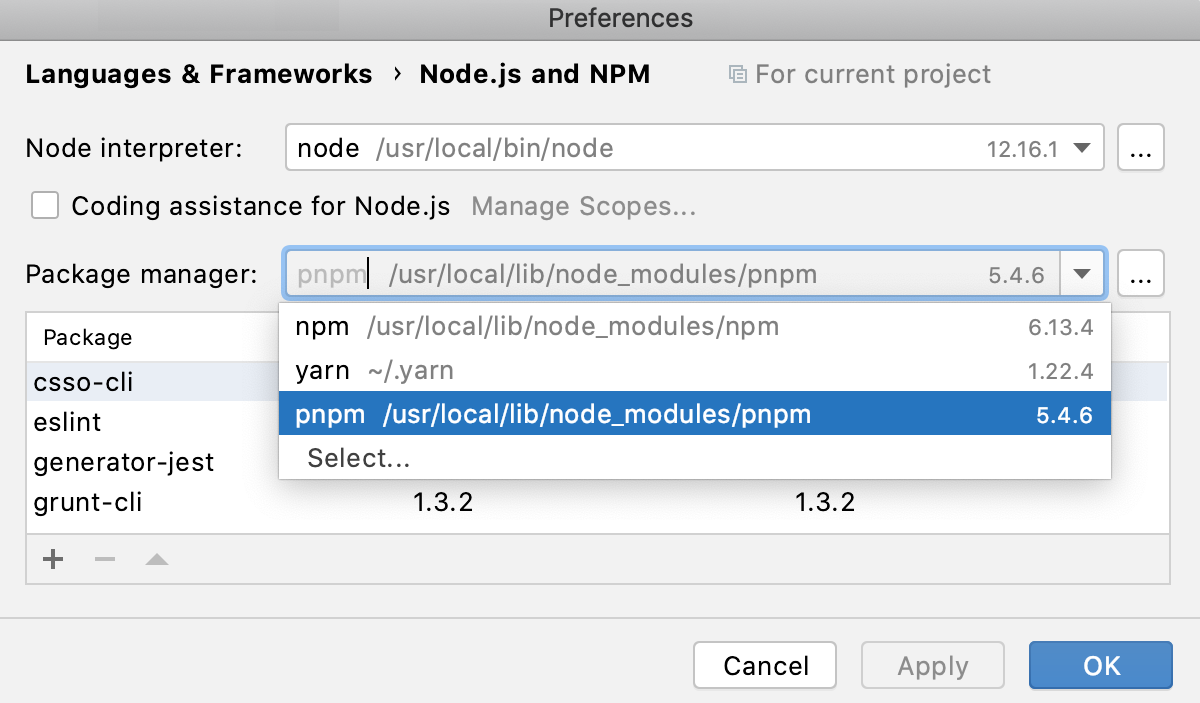
Select npm, yarn, or pnpm to use the system default installation.
To use a custom installation of a package manager, click Select, and select the installation folder of the relevant package manager.
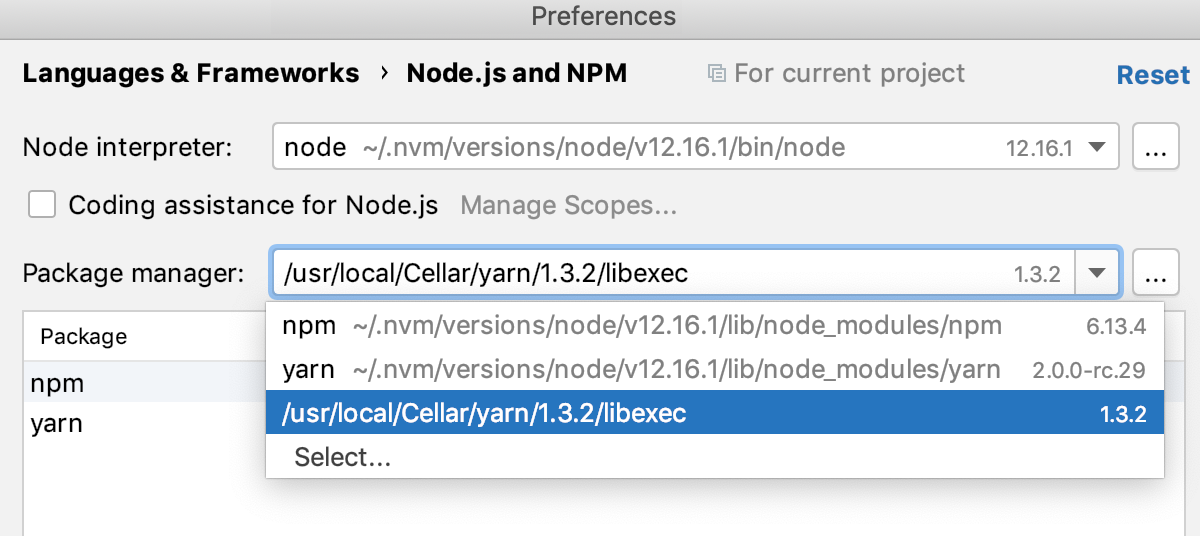
JetBrains Rider automatically uses the chosen package manager when you select the
Projectalias from the Package manager list in the Run/Debug Configuration: NPM dialog. JetBrains Rider also uses the path to the chosen package manager every time you invoke the Run 'npm install'/ Run 'yarn install'/ Run 'pnpm install' command or run an npm/Yarn/pnpm script, see Running and debugging scripts for details.
Set up Yarn 2 in your project
Make sure you have Yarn 1 installed globally and enable Yarn 2 in your project as described on the Yarn official website. Use the embedded Terminal Alt+F12 to type the commands.
In the Settings/Preferences dialog Ctrl+Alt+S, go to and select the path to the Yarn 2 package in your project from the Package manager list.
Set Yarn 1 or pnpm as the default JetBrains Rider package manager
Open the Settings for New Projects dialog () and go to .
On the Node.js and NPM page that opens, select
yarnorpnpmfrom the Package manager list.
After that, JetBrains Rider will suggest the selected package manager (Yarn or pnpm) as default every time you create a new project.
Edit package.json
JetBrains Rider helps you handle your project dependencies in package.json files providing extensive coding assistance.
Code completion for package names.
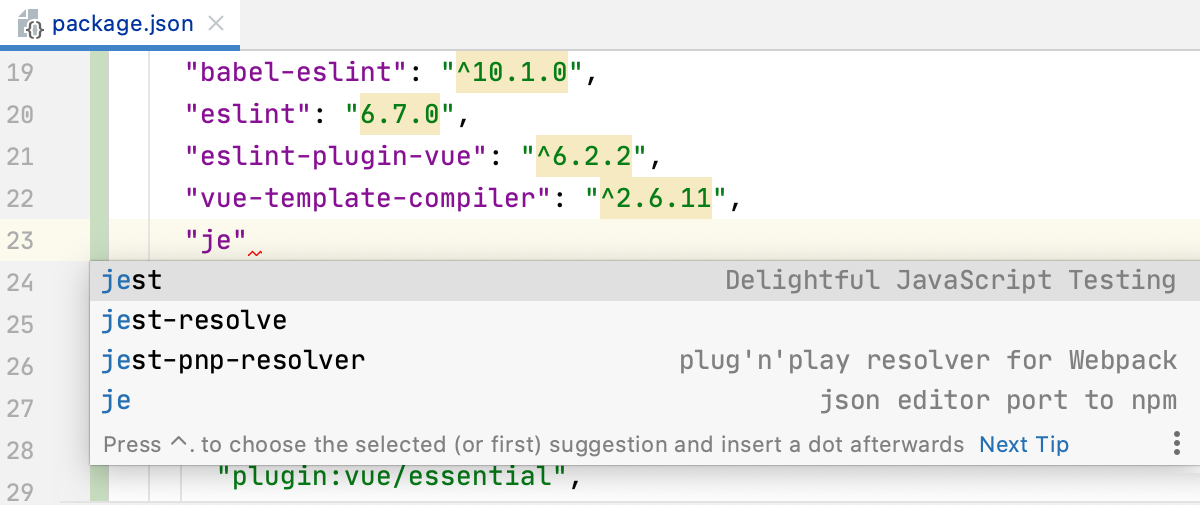
Information on the latest available package version.
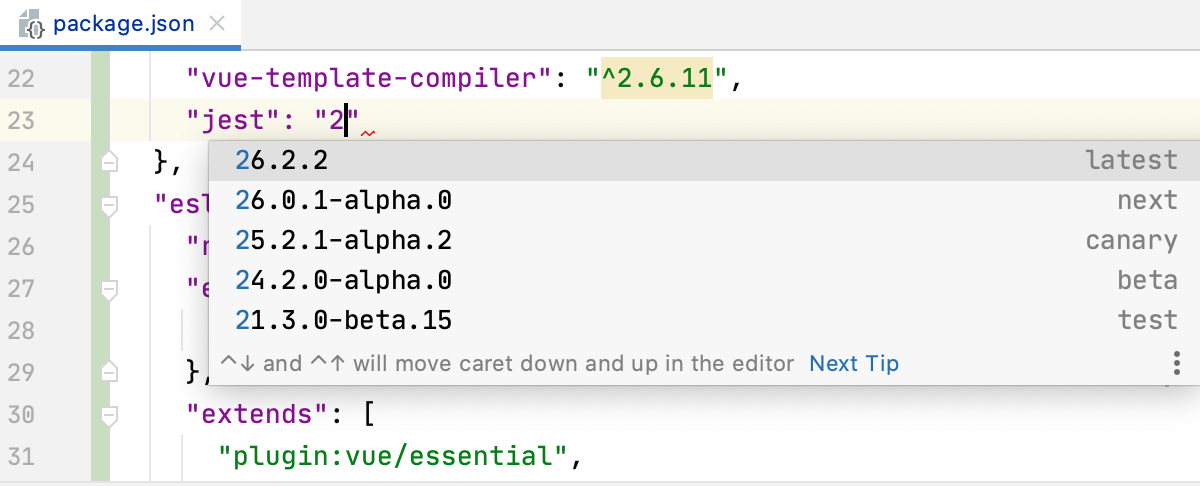
Information about the range of versions that can be installed through
npm install <package>@<version>oryarn add <package>@<version>. `Note that runningnpm installoryarn installwill install the latest available version from this range.Press Ctrl and hover over the version to see the information in a tooltip. See the npm Official documentation for details about semantic versioning.

Code completion for previous package versions. When you press Ctrl+Space or start typing a version different from the latest one, JetBrains Rider displays a suggestion list with all the previous versions of the package.
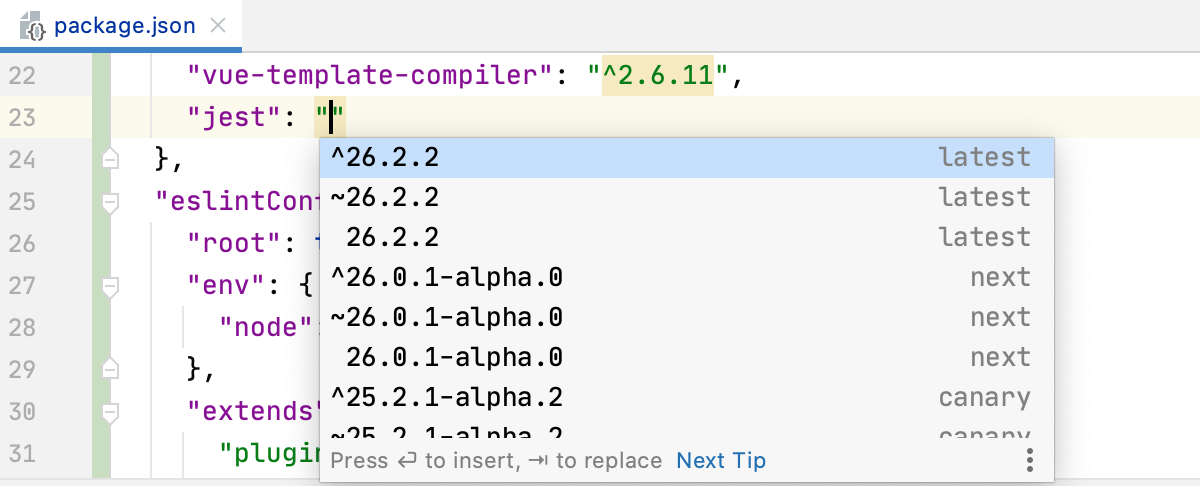
Quick documentation look-up for packages.
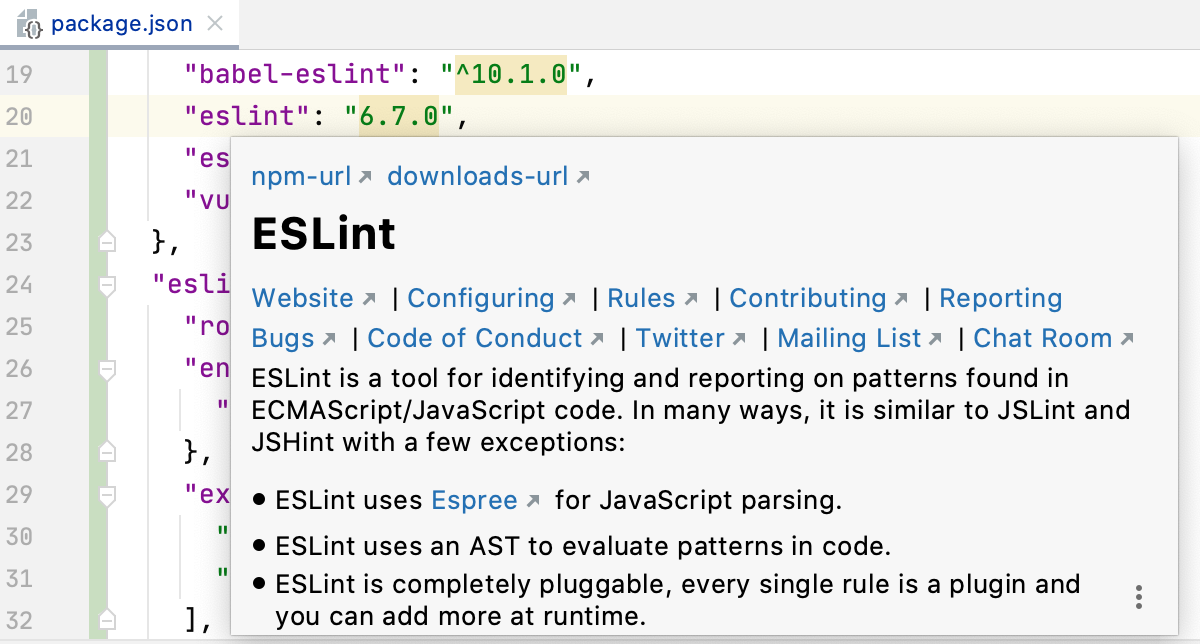
Install and update packages
As you may know, npm can install packages both globally or as project dependencies or development dependencies, learn more from the npm official website.
pnpm also installs packages globally or as project dependencies or development dependencies, learn more from the pnpm official website.
With Yarn, you can install packages globally or as project dependencies, see Yarn official website for details.
In JetBrains Rider, packages can be installed in the editor, from a package.json file, in the built-in Terminal Alt+F12, or on the Node.js and npm page.
From package.json
Install your project dependencies
Click the Run 'npm install', Run 'yarn install', or Run 'pnpm install' link in the popup:

JetBrains Rider shows this popup when the dependencies are not installed yet or when they have changed. If you close the popup or turn it off by choosing Don't ask again, you can still install the dependencies using the Run '<package_manager> install' action or in the built-in terminal.
If you have accidentally dismissed this notification and now want to get it back, press Ctrl+Shift+A, start typing
Enable notifications, and select Enable Notifications about Installing Dependencies from package.json from the list.Alternatively, open the relevant package.json file in the editor or select it in the Project tool window and choose Run 'npm install' from the context menu.
Update your project dependencies
Click Run '<package manager> install' in the popup.

JetBrains Rider shows this popup every time you open a project, update it from the version control, or edit a package.json.
JetBrains Rider also runs an inspection that checks whether the packages from
dependenciesordevDependenciesare installed and their versions match the specified range. If the inspection detects any mismatch, it suggests a quick-fix. To apply it, click the Run '<package manager> install' link.
In the built-in Terminal
In the embedded Terminal(Alt+F12), type one of the following commands:
For global installation:
npm install --global <package_name>yarn global add <package_name>pnpm --global add <package_name>
To install a package as a project dependency or a development dependency:
npm install --save <package_name>ornpm install --save-dev <package_name>yarn add <package_name> --devpnpm add --save-dev <package_name>
Install all dependencies listed in a package.json file
In the embedded Terminal(Alt+F12), type one of the following commands:
npm installyarn installpnpm install
As a result you get all the dependencies listed in the package.json from the current folder. Learn more from Editing package.json.
On the Node.js and NPM page
JetBrains Rider shows all the currently installed packages on the Node.js and NPM page. To open the page, in the Settings/Preferences dialog Ctrl+Alt+S, go to .
Globally installed packages are listed on top. For each package, JetBrains Rider shows its currently installed version and the latest available version.
Install a package
Click
and in the Available Packages dialog that opens, select the required package.
By default, the latest package version is installed. To install another one, select the Specify version checkbox and choose the required version from the list.
The default installation is local. To use another installation type, select the Options checkbox and type
-gfor global installation or--save/--save-devto install the package as a dependency/development dependency. Learn more from the npm and Yarn official websites.
View the location of a package
Hover the mouse pointer over the package name. JetBrains Rider shows the path to the package in a tooltip.
Update a package to the latest version
Select the package in the list and click
.
Remove a package
Select the package in the list and click
.
Run and debug scripts
You can launch npm, Yarn, or pnpm scripts from a package.json file in the editor, from a tree of scripts in the dedicated npm tool window, according to a dedicated run configuration, or automatically, as a start-up or a before-launch task.
The results of script execution are displayed in the Run window. The tool window shows the npm or Yarn script output, reports the errors occurred, lists the packages or plugins that have not been found, etc. The name of the last executed script is displayed on the title bar of the tool window.
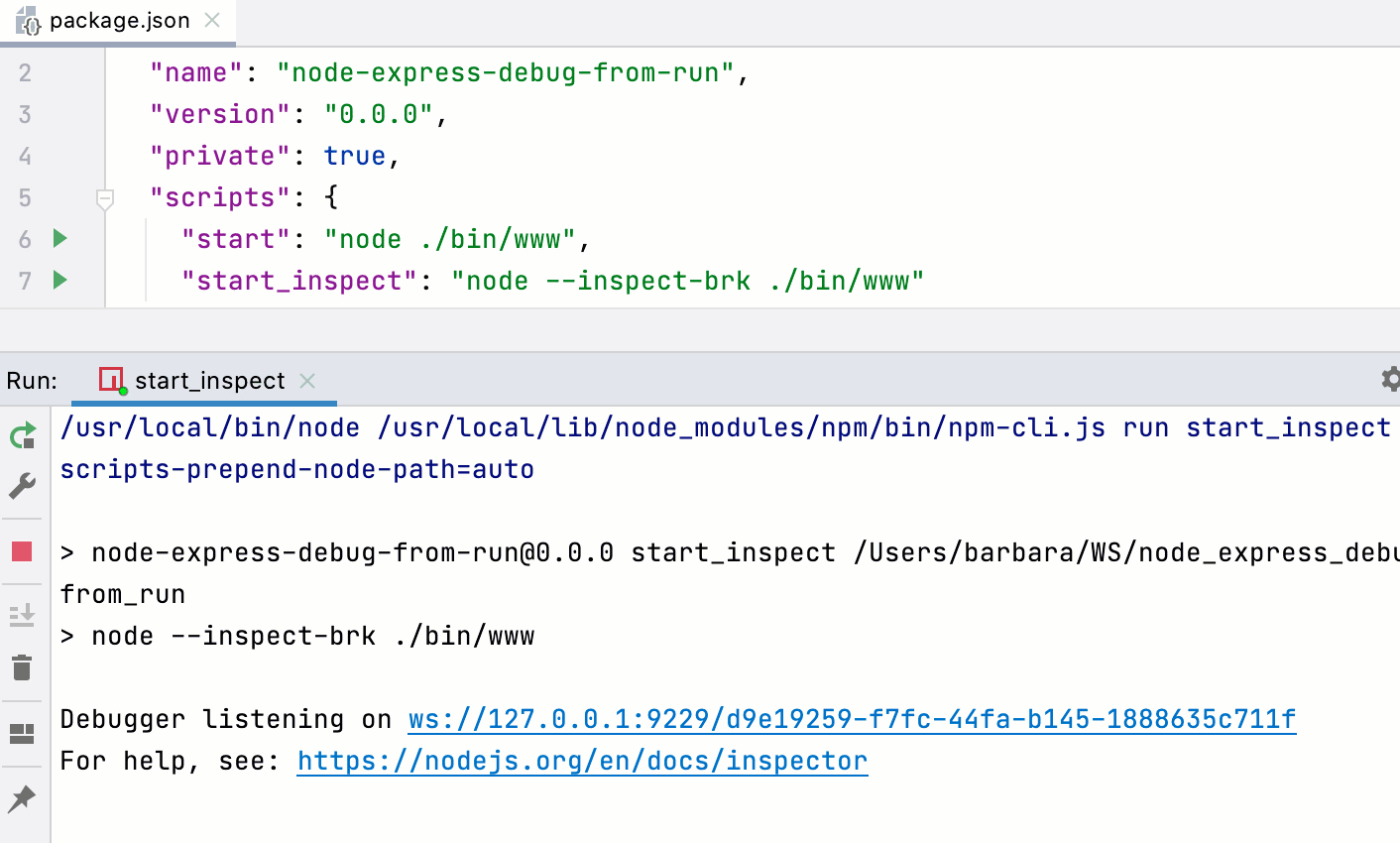
If you launch a script debugging session, JetBrains Rider opens the Debug window.
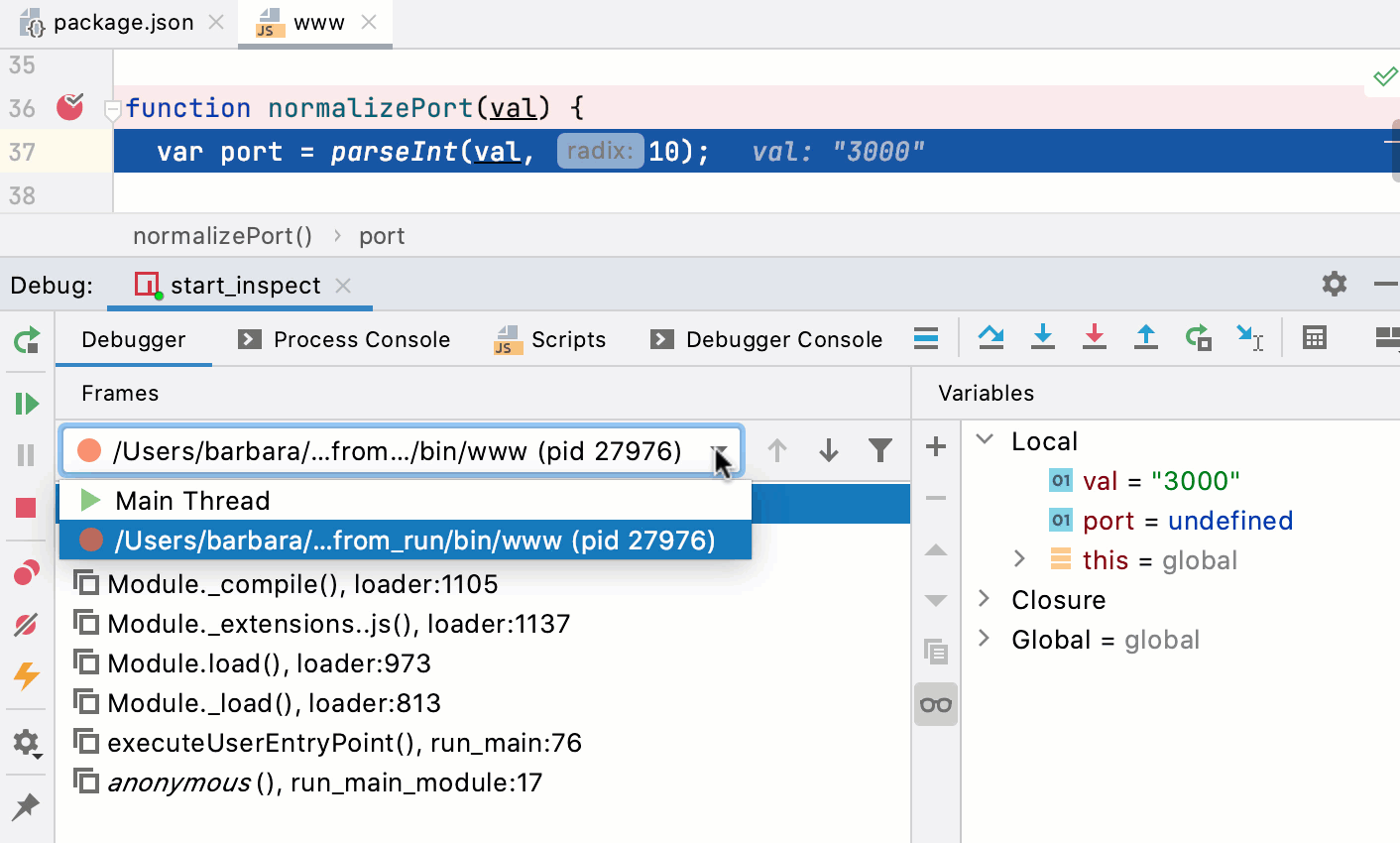
During a script debugging session, you can step through the script, stop and resume the script execution, examine it when suspended, run JavaScript code snippets in the Debugger Console, and so on.
Run and debug scripts from package.json
JetBrains Rider lets you quickly launch single scripts from package.json files. To run or debug several scripts, use a run configuration or the npm tool window.
Open the package.json file in the editor, click
in the gutter next to the script, and choose Run <script_name> or Debug <script_name> from the context menu.

You can also run a script by pressing Ctrl+Shift+F10.
The script output is shown in the Run tool window.
If you launch a script in the debug mode, JetBrains Rider opens the Debug window, where you can step through the script, stop and resume the script execution, examine it when suspended, run JavaScript code snippets in the Debugger Console, and so on.
Run and debug scripts from the npm tool window
The npm tool window opens when you select a package.json file in the Project tool window or open it in the editor and select Show npm Scripts from the context menu.
As soon as you invoke npm, pnpm, or Yarn, the tool starts building a tree of scripts defined within the scripts property of the package.json file on which it was invoked.
If you have several package.json files in your project, you can build a separate script tree for each of them and run scripts without dropping the previously built trees. Each tree is shown under a separate node.
Open the npm tool window if it is not opened yet
Select the required file in the Project tool window or open it in the editor and choose Show npm Scripts from the context menu.
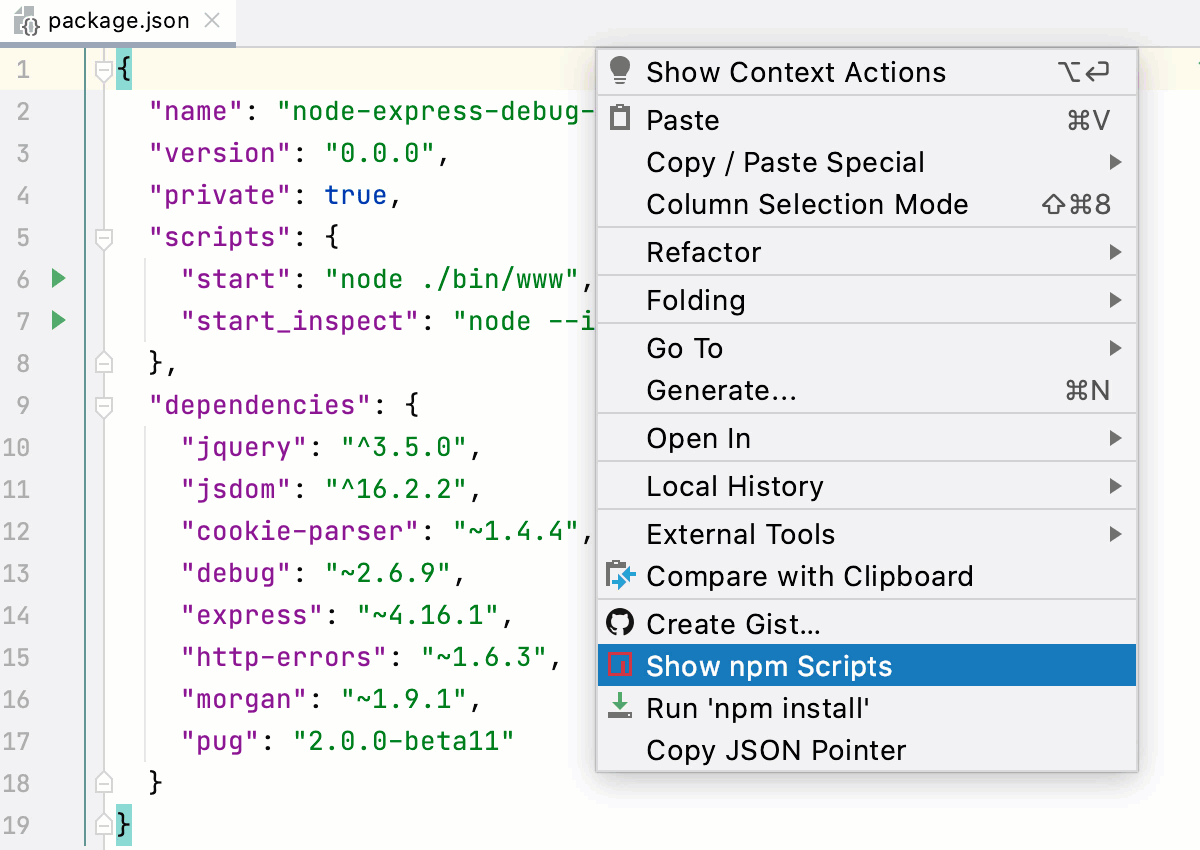
The npm tool window opens showing the scripts tree built according to the selected or opened package.json file.
Build a tree of scripts in an already opened npm tool window
In the npm tool window, click
on the toolbar and choose the required package.json file from the list. By default, JetBrains Rider shows the package.json file in the root of your project.
If you have another package.json file, click Choose package.json and select the package.json file you need in the dialog that opens. JetBrains Rider adds a new node with the path to the chosen package.json file on its title and builds a scripts tree under the new node.

Re-build a tree
Switch to the required node and click
on the toolbar.

Sort the scripts in a tree by their names
Click
on the toolbar, choose Sort by from the menu, and then choose Name.
By default, a tree shows the scripts in the order in which they are defined in package.json (option Definition order).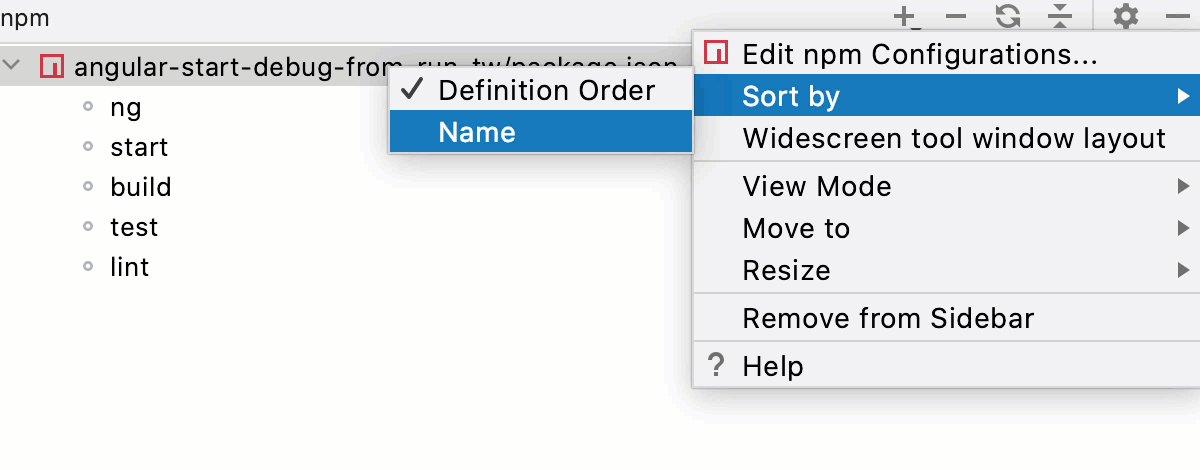
Run one script
Double-click the script.
Select the script in the tree and press Enter or choose Run <script name> from the context menu.
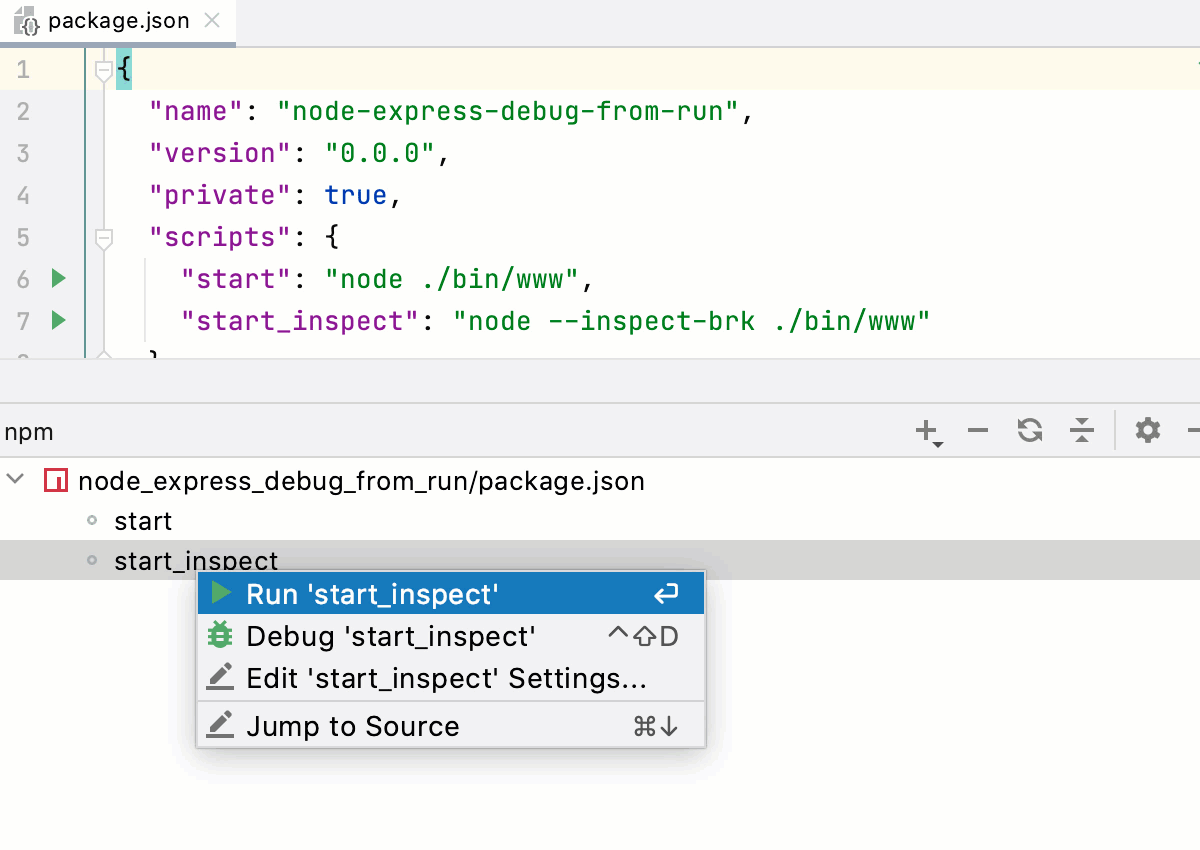
Debug one script
Select the script in the tree and choose Debug <script_name> from the context menu.
JetBrains Rider opens the Debug window where you can step through the script, stop and resume the script execution, examine it when suspended, run JavaScript code snippets in the Debugger Console, and so on.
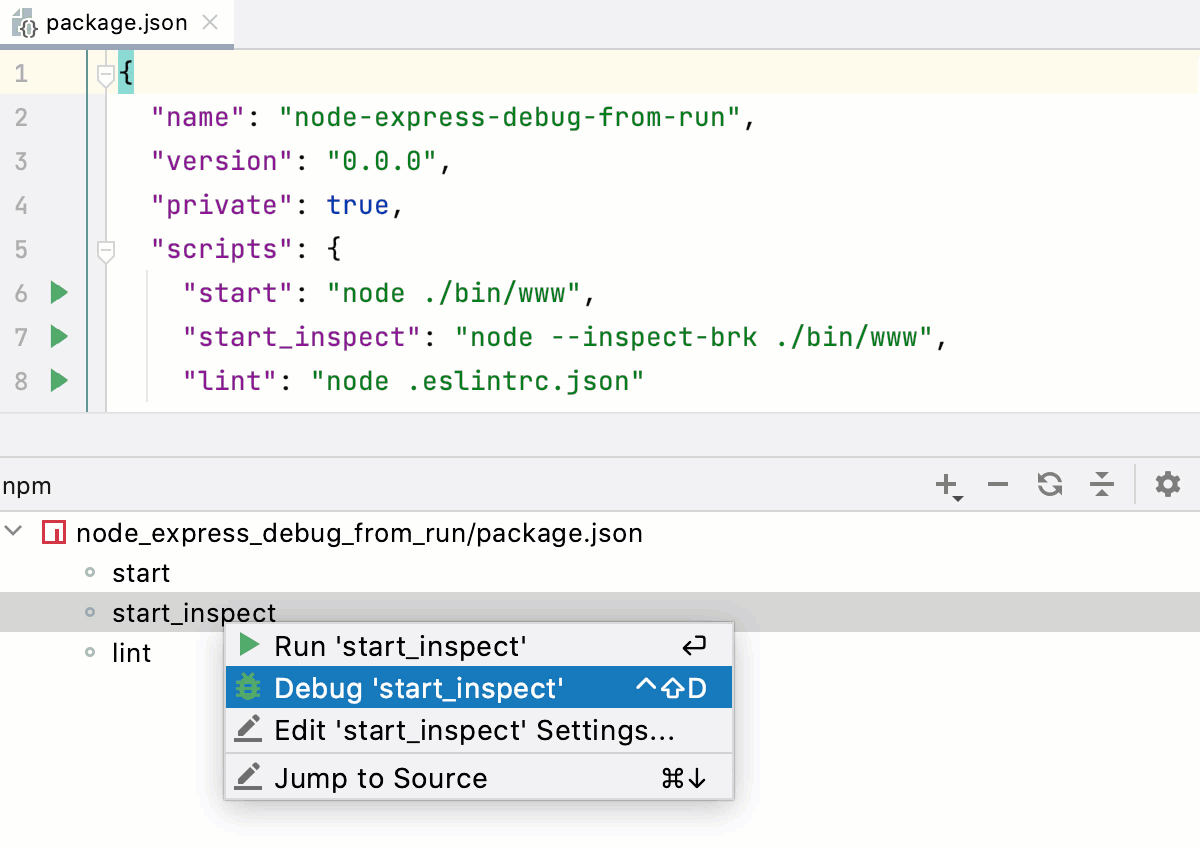
Run or debug several scripts
Use the multiselect mode: hold Shift (for adjacent items) or Ctrl (for non-adjacent items) keys and select the required scripts, then choose Run or Debug from the context menu of the selection.
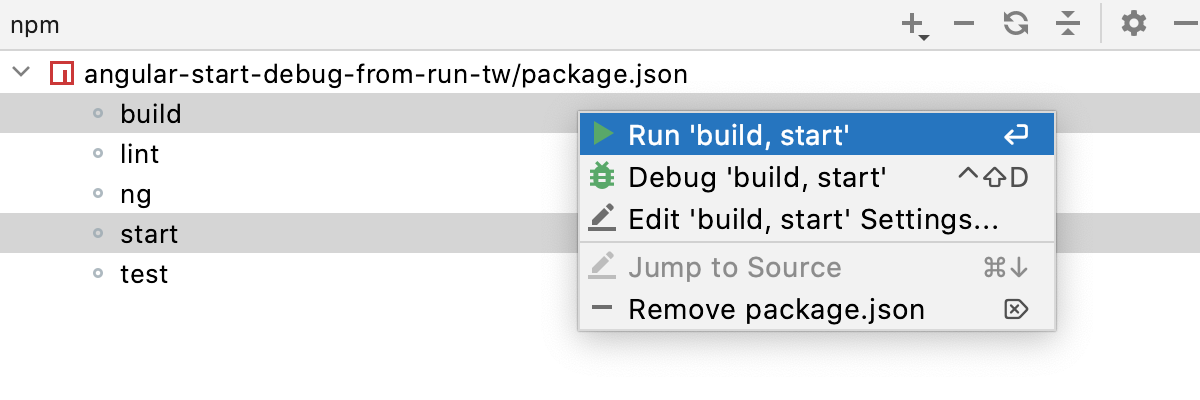
Run and debug scripts by a run configuration
When you run or debug scripts from the editor or from the npm tool window, JetBrains Rider automatically creates temporary run configurations. Besides using them, you can create and launch your own npm run configurations.
From the main menu, select .
Click
on the toolbar and select npm from the list. The Run/Debug Configuration: npm dialog opens.
Specify the CLI command to execute, the scripts to run (use blank spaces as separators), and the location of the package.json file where these scripts are defined. Optionally, type the command-line arguments for executing the scripts.
- Specify the Node.js interpreter to use. This can be a local Node.js interpreter or a Node.js on Windows Subsystem for Linux.
Optionally, specify the Node.js-specific option parameters and the environment variables to be passed to Node.js.
Specify the package manager to use. If you choose the
Projectalias, JetBrains Rider will use the default project package manager from the Node.js page. You can also choose the relevant package alias (npm or yarn) or specify an explicit path to a custom installation of a package manager.Select the newly created run configuration from the list on the toolbar and then click
or
next to the list.
The results of script execution are displayed in the Run tool window.
If you click
, JetBrains Rider opens the Debug window, where you can step through the script, stop and resume the script execution, examine it when suspended, run JavaScript code snippets in the Debugger Console, and so on.
Run scripts with Run Anything
Run Anything is a quick way to start scripts.
Press Ctrl twice or click
on the Navigation bar. The Run Anything popup opens.
Type
npm runoryarn runin the search field. As you type, JetBrains Rider shows the matching scripts. Select the required one from the list and press Enter.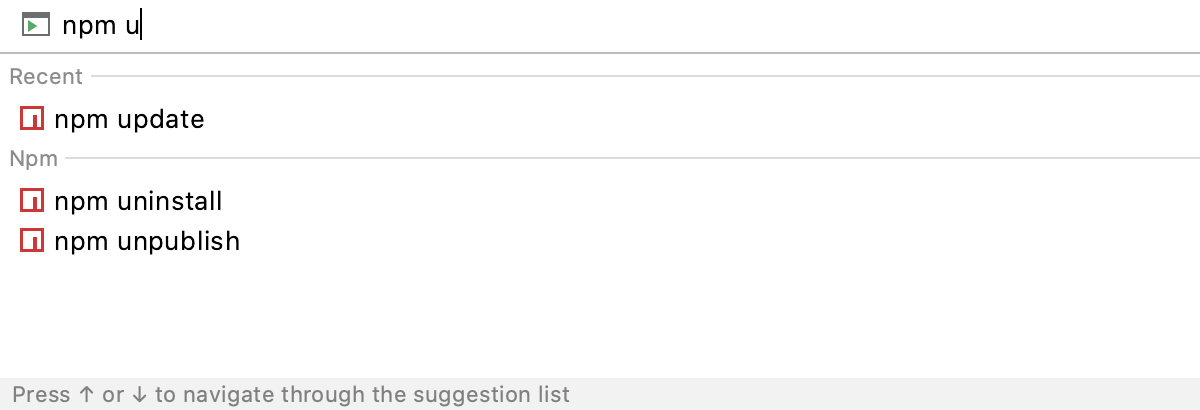
To view the command output in the Run tool window, press Ctrl+Enter, to show the output in the Debug tool window, press Shift+Enter.
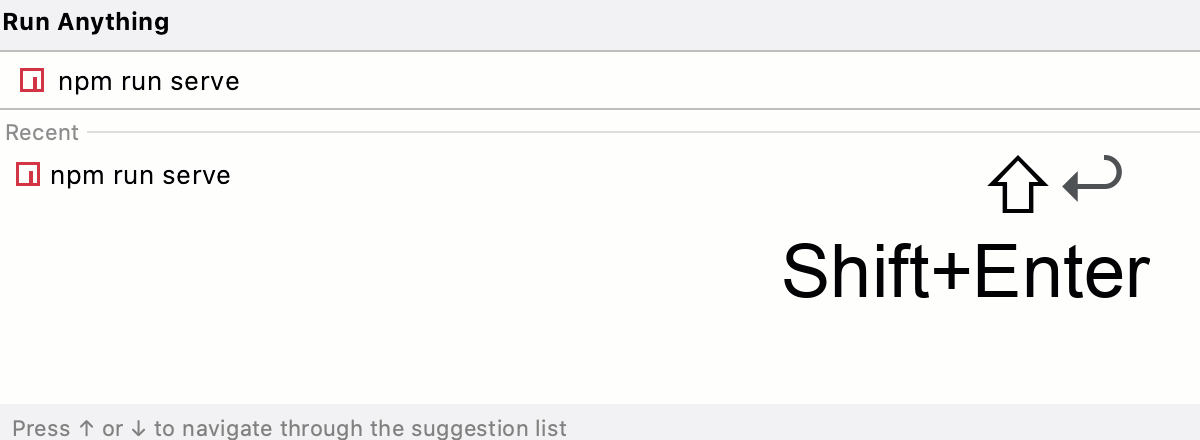
Run scripts automatically on start-up
If you have some scripts that you run on a regular basis, you can add the corresponding run configurations to a list of startup tasks. The tasks will be executed automatically on the project start-up.
In the Settings/Preferences dialog Ctrl+Alt+S, go to .
On the Startup Tasks page that opens, click
on the toolbar.
From the list, choose the required npm run configuration. The configuration is added to the list.
If no applicable configuration is available in the project, click
and choose Edit Configurations. Then define a configuration with the required settings on the Run/Debug Configuration: NPM page that opens. When you save the new configuration it is automatically added to the list of startup tasks.
Run scripts as before-launch tasks
Open the Run/debug configurations dialog dialog by choosing from the main menu, and select the required configuration from the list or create it anew by clicking
and choosing the relevant run configuration type.
In the dialog that opens, click
in the Before launch area and choose Run npm script from the list.
In the NPM Script dialog that opens, specify the npm run/debug configuration settings.